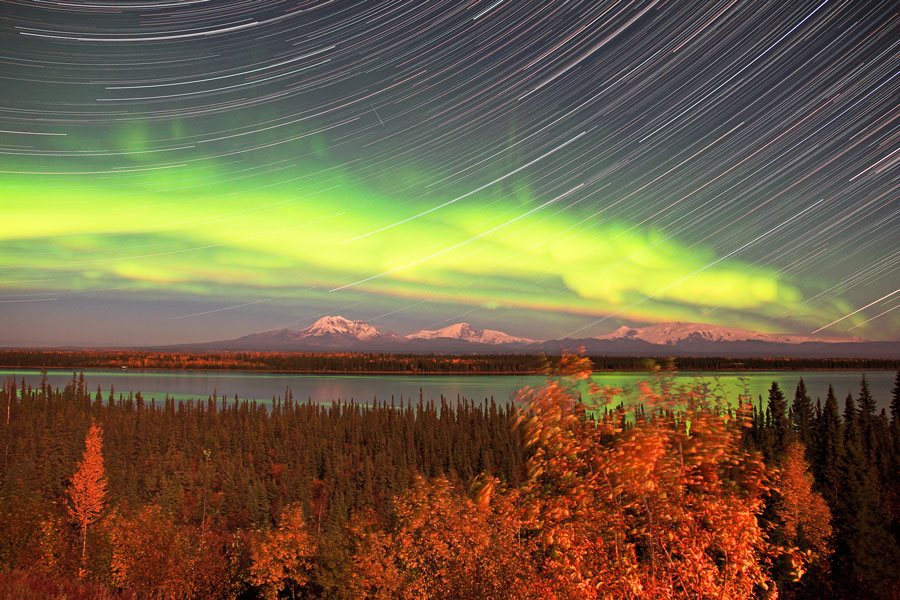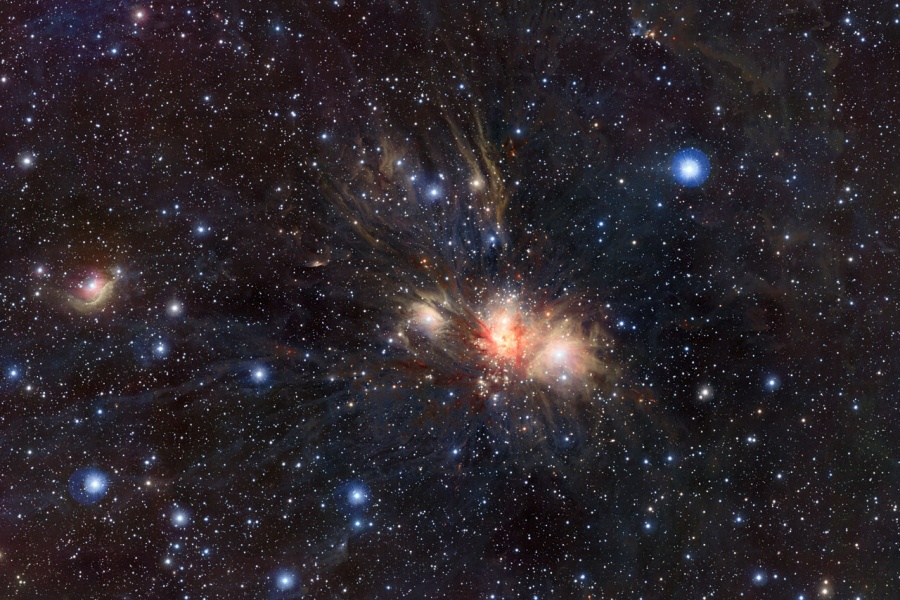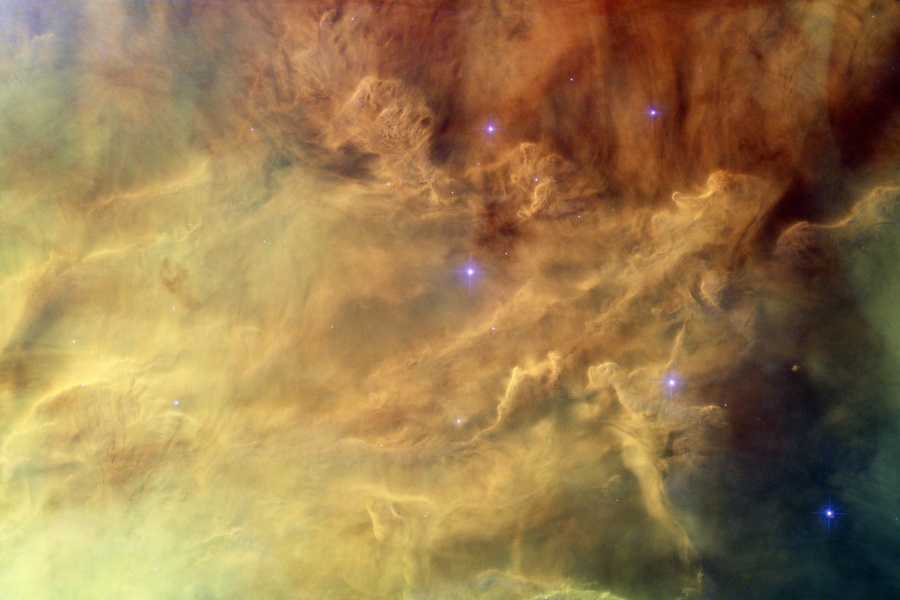Well, it's another post about aurora borealis. There's no doubt that the aurora makes for a good picture. This one was photographed about two weeks ago at Willow Lake in Eastern Alaska. The exposure time was two hours and sixteen minutes. The photographer included a video of the time elapsed which is really really sweet, http://www.flickr.com/photos/pmalsop/5031146657/, and at about 55 seconds a shooting star is visible. So cool so cool so cool. The aurora occurs a few days after a powerful magnetic event on the Sun when charged particles from the magnetosphere collide with air molecules in the Earth's atmosphere. I just love the coloration of this image.
Sunday, October 24, 2010
Tuesday, October 19, 2010
APOD 1.7
I chose this photo as it seemed very relevant due to our recent studies of the electromagnetic spectrum and infrared telescopic instruments. This image was taken very near infrared in an attempt to get past the dust of NGC 2170 and see the formation of stars and newborn stars that would have otherwise been hidden. This active star forming region is called Monoceros R2 and is about 2700 lightyears distant. This picture shows the importance of infared and radio wave technology so that we can see through the interstellar dust that is opaque to visible light. With only visible light telescopes, we would have little information about the early stages of stellar formation. I'm pretty excited for ESO's current plans for a 42-metre E-ELT, the European Extremely Large Telescope, which will classify as optical/near infrared, to be built in the Atacama desert in Chile. Astronomers really know how to get crazy naming their telescopes, don't they?
APOD 1.6

This image was the astronomy picture of the day on October 16th and it depicts the large cloud of Magellan. Unfortunately, this cloud and its brother the Small Cloud of Magellan are visible to the Southern hemisphere only. The Large Magellan Cloud is a satellite galaxy of the Milky Way named after who but Ferdinand Magellan, the Spanish explorer who discovered it during his trip around the world in 1519. The LMC is about 180,000 lightyears distant and resides in the constellation, Dorado. Also depicted in this photo in the top left is the Tarantula Nebula, a vast star forming region that spans 1,000 lightyeas across.
Thursday, October 14, 2010
Quarter 1 Astronomer Post -- Galileo Galilei
Astronomer Project: Galileo Galilei
He’s the father of modern observational astronomy and probably the first scientific figure that one studies in their pursuit of knowledge. He is one of the prominent figures to come out of the Scientific Revolution in Italy. A physicist, mathematician, astronomer, and philosopher, his observations and discoveries provide the groundwork for modern astronomy as we know it. He was born into a noble family iin Pisa, Italy on February 15, 1564, to Vincenzo Galilei. His father was a proficient musician who contributed greatly to the theory and practice of music. Galileo went to school at the University of Pisa to study medicine, but was quickly captivated by mathematics and philosophy and switched to make the study of Aristotelian philosophy his profession, despite his father’s wishes that he pursue medicine. In and out of his university career, Galileo’s work in the study of motion, his hydrostatic balance design, the invention of the pump and many gravitational theorems won him respect throughout the scientific community and a patron, Guidobaldo de Monte.
While sitting as the chair of mathematics at the University of Pisa, Galileo made the major discovery that we all know him for. He dropped bodies of different weights from the top of the Leaning Tower of Pisa, demonstrating that the speed at which they fell was not proportional to its weight. This discovery was in complete contradiction of Aristotle’s widely accepted claim that the falling speed of an object was entirely proportional to its weight. This blatant deviation from the status quo and his blatant disregard of the entire Aristotlean school of thought lost Galileo his position at the University of Pisa and many of his colleagues turned against him. He was picked up by the University of Padua. Upon hearing of the invention of the telescope in the Netherlands, Galileo quickly began work on creating his own telescope. Not only did he create his own telescope using spyglass lenses from a spectacle maker’s shop, but he also improved the instrument. He presented his creation to the Venetian Senate, gaining him a life tenure and doubling his salary.
It was in 1609 that Galileo began to observe the heavens from an instrument that magnified 20x. It was with the telescope that Galileo made his biggest contributions to science. He observed and drew the phases of the moon and observed the craters and imperfections of the moon’s surface. In January of 1610, he discovered four moons revolving around Jupiter, Io, Europa, Callisto, and Ganymede. He observed the rings of Jupiter and the phases of Venus, and the sun spots and solar flares that make the sun the imperfect entity that it is. Each of these groundbreaking observations led to further support of the Copernican heliocentric theory. After publicly submitting to the Copernican theory, Galileo encountered opposition on all fronts. The Church and the Inquisitors of the time saw the Copernican theory as a blatant rejection of the Bible and silenced Galileo with threats. Upon receiving approval from Pope Urban VIII, Galilei was able to publish Dialogue Concerning the Two Chief World Systems, Ptolemaic & Copernican, which was to maintain the Copernican theory strictly as a hypothetical possibility. The Romans did not think it was objective enough and charged him of heresy and sentenced him to a life of imprisonment. He continued to work even during his comfortable stint at the home of a Vatican ambassador. It was not untill about 1700, more than fifty years after his death in 1642 that the heliocentric universe was finally accepted, but the effects Galileo Galilei’s work in modern science and mathematics have been felt through out the ages.
He’s the father of modern observational astronomy and probably the first scientific figure that one studies in their pursuit of knowledge. He is one of the prominent figures to come out of the Scientific Revolution in Italy. A physicist, mathematician, astronomer, and philosopher, his observations and discoveries provide the groundwork for modern astronomy as we know it. He was born into a noble family iin Pisa, Italy on February 15, 1564, to Vincenzo Galilei. His father was a proficient musician who contributed greatly to the theory and practice of music. Galileo went to school at the University of Pisa to study medicine, but was quickly captivated by mathematics and philosophy and switched to make the study of Aristotelian philosophy his profession, despite his father’s wishes that he pursue medicine. In and out of his university career, Galileo’s work in the study of motion, his hydrostatic balance design, the invention of the pump and many gravitational theorems won him respect throughout the scientific community and a patron, Guidobaldo de Monte.
While sitting as the chair of mathematics at the University of Pisa, Galileo made the major discovery that we all know him for. He dropped bodies of different weights from the top of the Leaning Tower of Pisa, demonstrating that the speed at which they fell was not proportional to its weight. This discovery was in complete contradiction of Aristotle’s widely accepted claim that the falling speed of an object was entirely proportional to its weight. This blatant deviation from the status quo and his blatant disregard of the entire Aristotlean school of thought lost Galileo his position at the University of Pisa and many of his colleagues turned against him. He was picked up by the University of Padua. Upon hearing of the invention of the telescope in the Netherlands, Galileo quickly began work on creating his own telescope. Not only did he create his own telescope using spyglass lenses from a spectacle maker’s shop, but he also improved the instrument. He presented his creation to the Venetian Senate, gaining him a life tenure and doubling his salary.
It was in 1609 that Galileo began to observe the heavens from an instrument that magnified 20x. It was with the telescope that Galileo made his biggest contributions to science. He observed and drew the phases of the moon and observed the craters and imperfections of the moon’s surface. In January of 1610, he discovered four moons revolving around Jupiter, Io, Europa, Callisto, and Ganymede. He observed the rings of Jupiter and the phases of Venus, and the sun spots and solar flares that make the sun the imperfect entity that it is. Each of these groundbreaking observations led to further support of the Copernican heliocentric theory. After publicly submitting to the Copernican theory, Galileo encountered opposition on all fronts. The Church and the Inquisitors of the time saw the Copernican theory as a blatant rejection of the Bible and silenced Galileo with threats. Upon receiving approval from Pope Urban VIII, Galilei was able to publish Dialogue Concerning the Two Chief World Systems, Ptolemaic & Copernican, which was to maintain the Copernican theory strictly as a hypothetical possibility. The Romans did not think it was objective enough and charged him of heresy and sentenced him to a life of imprisonment. He continued to work even during his comfortable stint at the home of a Vatican ambassador. It was not untill about 1700, more than fifty years after his death in 1642 that the heliocentric universe was finally accepted, but the effects Galileo Galilei’s work in modern science and mathematics have been felt through out the ages.
Sunday, October 3, 2010
APOD 1.5
Hello. This one looks sort of like the one I featured last week. But it's so prettttyyy. Meet Messier 8, your average star forming region coming in at about 5,000 lightyears distant from Sagittarius. M8 is commonly known as the Lagoon nebula. This is another image from our good friend Hubble. The dust clouds reflect the bright light emitted from the newborn stars to create this beautiful effect.
Friday, October 1, 2010
The Night Sky 09/30/10
Where? Blackburn point
When? 8:20-9:30
Holy smokes! I attended the stargaze last night at Blackburn point, and it was better than I ever could have imagined. I have finally seen proof that the constellations we study each week actually exist. The patterns on our star charts mirror the patterns in the sky. No really. Last night, my mind was blown. We had stationary binoculars set up to see some really awesome clusters of the Milky Way. With the telescope we viewed Venus before it set and Jupiter and its moons. Jupiter was so big and lovely. With binoculars we could see the Andromeda galaxy. It looked like a little smudge, but it was cool nonetheless. So there we all are, minding our own business when a large meteor just fell right out of the sky. I made a wish. But even if my wish doesn't come true, at least I got to share a beautiful night of stargazin' with my buds.
When? 8:20-9:30
Holy smokes! I attended the stargaze last night at Blackburn point, and it was better than I ever could have imagined. I have finally seen proof that the constellations we study each week actually exist. The patterns on our star charts mirror the patterns in the sky. No really. Last night, my mind was blown. We had stationary binoculars set up to see some really awesome clusters of the Milky Way. With the telescope we viewed Venus before it set and Jupiter and its moons. Jupiter was so big and lovely. With binoculars we could see the Andromeda galaxy. It looked like a little smudge, but it was cool nonetheless. So there we all are, minding our own business when a large meteor just fell right out of the sky. I made a wish. But even if my wish doesn't come true, at least I got to share a beautiful night of stargazin' with my buds.
Subscribe to:
Posts (Atom)


